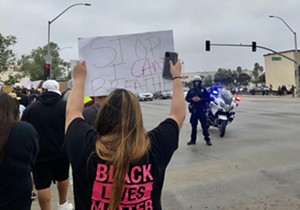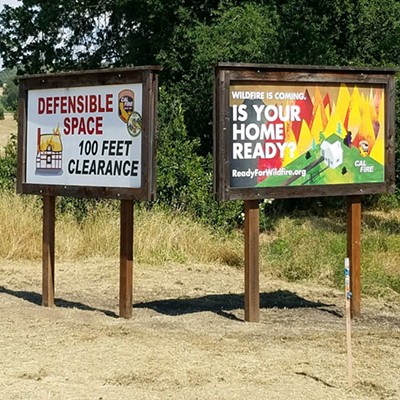The protests that erupted in early and mid June across the country in response to systemic racism and police brutality came at a pivotal moment for local governments, as many cities raced to finalize their budgets before the new fiscal year hits on July 1.

Amid a pandemic-induced recession, many cities are faced with financially reassessing their priorities. And given many protesters’ and organizations’ demands to change how money is allocated to public safety, police departments whose budgets eat up one of the largest slices of the local government pie have become the proverbial elephant in the room as city council members cast their votes.
At least, those were the words of community member Gale McNeeley at Santa Maria’s June 16 City Council meeting, where a proposed two year budget passed 4-1. The budget allocates 63 percent of the general fund to public safety for 2020-21, 42 percent of which goes to the police.
“Tonight I am proposing that Santa Maria lay off all new police and firefighters to provide more money for services for youth and families,” McNeely said during public comment. “The elephant in the room is the fact that all the money is going to [public] safety, and not enough to youth services.”
About three hours before McNeeley and others took the virtual microphone to voice their thoughts on the budget, chants from a protest outside filtered through the meeting’s livestream. Organized by the Santa Maria Youth Abolitionists, the rally called for defunding the Santa Maria Police Department and a community review of the budget before it’s voted on, according to a Lompoc Valley Democratic Club Instagram post.
Santa Maria Councilmember Gloria Soto told the Sun that she was surprised by how fast the budget process was, and how little time the community had to review it. Soto was the only dissenting vote against the budget.
A grievance brought up by protesters and public commenters alike is the discrepancy between cuts made to the police department’s budget versus cuts to public services like the city library and the Paul Nelson Aquatic Center. Police saw a 1.9 percent budget decrease from the year before, while the library saw a 12.6 percent decrease, and the pool saw a 52 percent decrease.
Because of these cuts, the library was slated to remain closed through September, and the pool through January. After hours of discussion, the council decided to use capital funds from non-urgent projects to open the library and pool as soon as possible.
Although protesters and community members saw some of their demands met—more funds allocated toward public services—the means to those ends weren’t quite what they rallied for. The police department’s proposed funding remained untouched, and the request for a community review of the budget didn’t come to fruition.
Councilmember Etta Waterfield, the executive director of the Santa Maria Police Council, advocated strongly for finding a way to reopen the pool. However, she told the Sun after the budget passed that she had “no intention of defunding our police department.”
“The community cannot raise itself with feel-good programs,” she said.
Councilmember Mike Cordero, a former police officer, told the Sun that while he believes defunding the police is a “poor choice of words,” he’s not generally opposed to reallocating money as long as responsibilities are reallocated too.
“I think that anything we can do to curb crime is a better thing. If we can do that with dialogue, then that’s great,” he said. “And if that means we have 10 less officers in the police department, I don’t have any problems with that either, as long as there’s an appropriate amount of work that is distributed to people that are going to be handling these calls.”
Councilmember Michael Moats didn’t respond to the Sun’s request for comment. However, he did bring up another hot topic at the June 16 meeting: funding for body cameras for police officers.
Moats asked Santa Maria Police Chief Phil Hansen about the fact that his department asked for funds to buy body cameras, but the request didn’t make the budget. Given the pandemic-related loss of revenues for the city, city staff determined that there wasn’t enough money to fund body cameras this time around. But City Manager Jason Stilwell said he hopes to see a line in the budget for body cameras in 2022-23. Hansen added that, until then, the department will be looking to grants to potentially fund the technology.
Sgt. Alfredo Ruiz of the Santa Maria Police Department told the Sun that the city currently doesn’t have or use body cameras, “but we do have car video cameras in all of our patrolling [cars],” he said.
Lompoc is in a similar situation, according to Mayor Jenelle Osborne.
“The issue is that, once again, limited budget,” Osborne told the Sun. “A couple years ago, [former Police] Chief Walsh was asked to present body cam estimates, and the cost exceeded a million, and we didn’t have that at the time.”
As community members chanted outside Santa Maria City Hall on June 16, so too did rally organizers in Lompoc. While Lompoc’s biennial 2019-21 budget was approved last year, the budget was put on the agenda for the City Council’s June 16 meeting, prompting community members to come speak their minds.
Lompoc’s rally was organized by Building BLOCK (Black & Latinx Offering Community & Knowledge), a recently formed group committed to “serving the underserved community of Lompoc,” the group’s social media states.
The protest was the organization’s first call to action. Building BLOCK organizers and others then took the podium during public comment to question the way that funding is distributed in the Lompoc budget.
“Personally, police chief, I don’t think you guys need a [Ford] F-150 truck … . If you go and talk to the youth, they’re starving for something to do,” said Keith Joseph, vice president of Building BLOCK. “You wonder about gang violence and why all these 15-year-olds are on probation doing drugs? Because there’s nothing to do.”
Another community member said that if Lompoc wants to stop violence, “that means providing resources for the youth and the marginalized communities.
Councilmember Jim Mosby questioned where they were going to find the money for that.
“That same year, there was a 9 percent raise for police officers,” the commenter continued. “The money for these resources for the youth can come out of the act of defunding the police.”
Mosby told the Sun that he believes advocates with organizations like Building BLOCK need a better understanding of where the money comes from for certain programs.
“They’re concerned about mental health and homelessness,” Mosby said. “The county collects the money for that. The city is limited with where we get our money from.”
Mosby said that he supports implementing body cameras. He also said he believes the police department has been overfunded before, citing the department not utilizing its full budget allocation in the past.
When the current biennial budget passed last year, the Lompoc Police Department’s general fund allocation rose by about $1.3 million, a 13 percent increase from the year before.
Building BLOCK organizer KyungSoon Richardson told the Sun that she believes there’s an overall “lack of understanding of what defunding the police actually means.”
“There were comments from other city members saying that we can’t defund the police because we need the police, but that’s not the message that we were trying to put out,” Richardson said. “It’s that they request however much money, and yet, we still don’t have resources or money for the schools or for youth programs. There was a misconception of our message of what we were trying to present to the council.”
Reach Staff Writer Malea Martin at [email protected].












